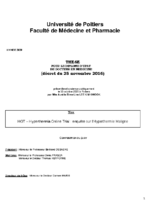Thèse d'exercice
Lee Kim Khiook Aurélie
HOT – Hyperthermia Online Trial : enquête sur l'Hyperthermie Maligne
AnglaisConsulter le texte intégral (format PDF)

Résumé
Français
HOT – Hyperthermia Online Trial : enquête sur l'Hyperthermie Maligne
- Hyperthermie maligne peranesthésique
- Anesthésie
- Anesthésistes -- France
- Dantrolène
- Complications anesthésiques
English
Background : Malignant hyperthermia may be an uncommon disease, but it can quickly be lethal should an effective treatment be delayed. The aim of this study is to assess how well the French anaesthetists and intensivists are trained in theory (tuitions received…) and in practice (knowledge of protocols, accessibility to Dantrolene…) in order to treat malignant hyperthermia.
Methods : This study is based on an anonymous self-reporting survey; thus, the consent of the participants is obtained per se. The questionnaire was designed with the surveymonkey.com website and diffused by the French Society of Anaesthesia and Intensive Care (SFAR) via its mailing list.
Our main objectives are to estimate the number and the type of teachings received by the participants; as well as their preparation on the field (knowledge of the protocols, accessibility to Dantrolene…). Our other objectives are to quantify the number of malignant hyperthermias (both the suspected cases and the confirmed ones); and the number of anaesthetists who are used to seeking its risk factors in their preoperative consultations.
The statistical analyses were performed with the use of the surveymonkey.com website and the Microsoft Excel software.
Findings : 670 French anaesthetists and intensivists took part in the study. 63% of them have been practising for more than 10 years and 71% work in operating theatres. 99% of interrogatees either use depolarizing curare or halogenated gas or both of them.
11% of respondents never had any tuitions about the treatment of malignant hyperthermia. Among those who did receive some teachings, 65% attended to 2 sessions or less. Moreover, 44% of participants consider that the tuitions provided are not enough to treat this disease properly.
About on-field preparations, 7% of respondents don't know the treatment protocol; and in 8% of cases, it doesn't exist at all. As well, 35% of interrogatees never took knowledge of the cognitive aid issued by the SFAR. However, 86% of participants have access to Dantrolene in their own ward and in 77% of cases it is available in less than 5 minutes. But 12% of respondents don't know how to use it.
In their professional practice, 29% of participants had to deal with a suspected case of malignant hyperthermia (amongst which 36% of genuine malignant hyperthermias confirmed by gold-standard tests). Most physicians (61% overall) either remember feeling overwhelmed or admit that their medical care could have been improved.
During their preoperative consultations, 89% of all surveyed anaesthetists seek the risk factors of malignant hyperthermia amongst their patients.
Conclusions : Many anaesthetists and intensivists never had any teachings about the treatment of malignant hyperthermia; and those who did have some courses don't feel like they are trained enough. Although Dantrolene is quickly available, the treatment protocol still remains unknown to some of the participants; and in the worst cases it doesn't even exist.
This data points out the necessity for more frequent and more appropriate teachings about malignant hyperthermia. It is also crucial for the medical teams to consider the treatment protocols in order to improve their medical care against malignant hyperthermia, this serious but not-so-rare disease.
Notice
- Diplôme :
- Diplôme d'état de médecine
- Établissement de soutenance :
- Université de Poitiers
- UFR, institut ou école :
- Domaine de recherche :
- Médecine. Anesthésie réanimation
- Directeur(s) du travail :
- Damien Marie
- Date de soutenance :
- 30 octobre 2020
- Président du jury :
- Bertrand Debaene
- Membres du jury :
- Denis Frasca, Thomas Kerforne
Menu :
-
-
à propos d'UPétille
-
Voir aussi
Annexe :

-
Une question ?
Avec le service Ubib.fr, posez votre question par chat à un bibliothécaire dans la fenêtre ci-dessous ou par messagerie électronique 7j/7 - 24h/24h, une réponse vous sera adressée sous 48h.
Accédez au formulaire...
Université de Poitiers - 15, rue de l'Hôtel Dieu - 86034 POITIERS Cedex - France - Tél : (33) (0)5 49 45 30 00 - Fax : (33) (0)5 49 45 30 50
petille@support.univ-poitiers.fr -
Crédits et mentions légales
